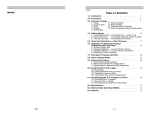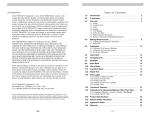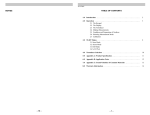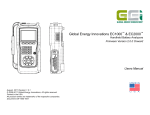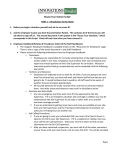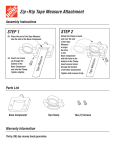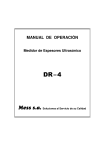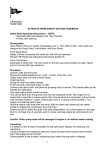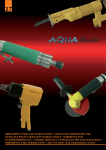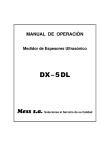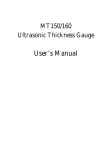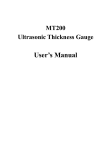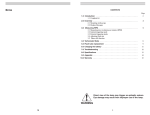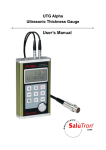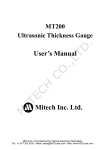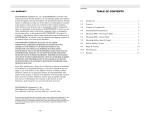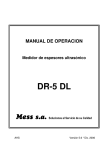Download ti-25lt ultrasonic thickness gauge
Transcript
OI-XXXXXX 9 .0 WARRAN T Y T ABLE ELECTROMATIC Equipment Co., Inc. (ELECTROMATIC) warrants to the original purchaser that this product is of merchantable quality and confirms in kind and quality with the descriptions and specifications thereof. Product failure or malfunction arising out of any defect in workmanship or material in the product existing at the time of delivery thereof which manifests itself within one year from the sale of such product, shall be remedied by repair or replacement of such product, at ELECTROMATIC’s option, except where unauthorized repair, disassembly, tampering, abuse or misapplication has taken place, as determined by ELECTROMATIC. All returns for warranty or non-warranty repairs and/or replacement must be authorized byELECTROMATIC, in advance, with all repacking and shipping expenses to the address below to be borne by the purchaser. THE FOREGOING WARRANTY IS IN LIEU OF ALL OTHER WARRANTIES, EXPRESSED OR IMPLIED, INCLUDING BUT NOT LIMITED TO, THE WARRANTY OF MERCHANTABILITY AND FITNESS FOR ANY PARTICULAR PURPOSE OR APPLICATION. ELECTROMATIC SHALL NOT BE RESPONSIBLE NOR LIABLE FOR ANY CONSEQUENTIAL DAMAGE, OF ANY KIND OR NATURE, RESULTING FROM THE USE OF SUPPLIED EQUIPMENT, WHETHER SUCH DAMAGE OCCURS OR IS DISCOVERED BEFORE, UPON OR AFTER REPLACEMENT OR REPAIR, AND WHETHER OR NOT SUCH DAMAGE IS CAUSED BY MANUFACTURER’S OR SUPPLIER’S NEGLIGENCE WITHIN ONE YEAR FROM INVOICE DATE. Some State jurisdictions or States do not allow the exclusion or limitation of incidental or consequential damages, so the above limitation may not apply to you. The duration of any implied warranty, including, without limitation, fitness for any particular purpose and merchantability with respect to this product, is limited to the duration of the foregoing warranty. Some states do not allow limitations on how long an implied warranty lasts but, not withstanding, this warranty, in the absence of such limitations, shall extend for one year from the date of invoice. OF 1.0 Introduction. . . . . . . . . . . . . . . . . . . . . . . . . . . . . . . . . . . . . . . . . . . . 3 2.0 Precautions . . . . . . . . . . . . . . . . . . . . . . . . . . . . . . . . . . . . . . . . . . . . 3 3.0 Overview of Gauge . . . . . . . . . . . . . . . . . . . . . . . . . . . . . . . . . . . . . 3.1 Gauge 3.2 Contents of Kit 3.3 Probe 3.4 Keypad 3.5 LCD Display 3.6 Probe Zero Plate 3.7 Probe Connector Receptacle 3.8 Battery Compartment (Battery Replacement) 4 4.0 Getting Started. . . . . . . . . . . . . . . . . . . . . . . . . . . . . . . . . . . . . . . . . 4.1 Connecting The Probe 4.2 Turn On The Power 4.3 “Zeroing” The Probe 4.4 Changing Units—inches to mm 4.5 Checking Calibration With The Test Plate 4.6 Preparation Of The Surface 09 5.0 Quick Start Instructions — Steel Thickness . . . . . . . . . . . . . . 10 6.0 Measuring Procedure . . . . . . . . . . . . . . . . . . . . . . . . . . . . . . . . . . 6.1 General Notes On Measurements 6.2 Measurements Of Pipes Or Cylindrical Parts 6.3 Measurements On Materials At High Temperatures 11 7.0 Specifications. . . . . . . . . . . . . . . . . . . . . . . . . . . . . . . . . . . . . . . . . . 14 8.0 Material Safety Data Sheet (MSDS) . . . . . . . . . . . . . . . . . . . . . . 15 9.0 Warranty. . . . . . . . . . . . . . . . . . . . . . . . . . . . . . . . . . . . . . . . . . . . . . . 16 ELECTROMACTIC Equipment Co., Inc. 600 Oakland Ave. Cedarhurst, NY 11516—USA Tel: 1-800-645-4330/ Tel: 516-295-4300/ Fax: 516-295-4399 Every precaution has been taken in the preparation of this manual. Electromatic Equipment Co., Inc., assumes no responsibility for errors or omissions. Neither is any liability assumed for damages resulting from the use of information contained herein. Any brand or product names mentioned herein are used for identification purposes only, and are trademarks or registered trademarks of their respective holders. – 16 – C ON T EN T S –1– 1 .0 8 .0 M AT ERI AL S AFET Y D ATA S H EET (M SDA) I N T RODU CT I ON The CHECK•LINE® TI-25LT Ultrasonic Thickness Gauge accurately measures the thickness of steel. This gauge uses the “pulse-echo” principle of ultrasonic testing where a short ultrasonic signal is transmitted from the probe. The signal travels through the measurement sample until it is reflected back towards the probe from the back side of the material. The elapsed time for the complete cycle is measured and converted to an accurate thickness reading. The TI-25LT can be used to measure the extent of corrosion on the opposite, inaccessible side of the wall by using the “Subtractive Method.” When the thickness of the original wall is known, subtracting the thickness reading obtained from the TI-25LT will determine the extent of corrosion at the point of probe placement. If the original wall thickness is not known, test readings should be made along a grid of equally-spaced points to obtain a profile of the thickness readings. The smallest thickness reading will locate the area of greatest concern. The TI-25LT is factory-set to measure steel. As a “no cost” option, the TI-25LT can be factory set to measure on any other single material instead of steel. However, it can never be used for more than one material. If this capability is required, contact Electromatic to purchase the TI-25M upgrade explained below. Easy upgrade to full TI-25M functionality (contact Electromatic for details). The TI-25M measures on all metals, ceramics, glass and most rigid plastics. It provides Single Reading and Scan modes, where the probe is dragged over a large measuring area. The minimum reading recorded during the “scan” is displayed. 2 .0 P RECAU T I ON S Do not use the standard probe in applications where material temperatures exceed 200 °F (100 °C) as the probe will be damaged. Special High Temperature Probes should be used. Consult factory. Keep the gauge free of dust (especially metal powders, carbon, etc.) as they will damage the gauge. Use a damp cloth to clean the gauge after use. DO NOT USE CHECMICAL SOLVENTS OF ANY KIND. Section 1— Product Identification Product Name: TI-25M Manufacturer: Electromatic Equpt. Co. Generic Name: Ultrasonic Couplant NFPA Hazardous Materials Identification System (est) Health 0 Flammability 0 Reactivity 0 Section 2— Hazardous Ingredients This material does not contain any ingredients having known health hazards in concentrations greater than 1%. This material does not contain any known or suspected carcinogens. Section 3 — Physical Data (nominal) Boiling Point: >220°F Vapor Pressure: N/A Specific Gravity: >1.0Z pH: 7.35 – 7.9 Vapor Density: N/A Freezing Point: <20°F Evaporation Rate: N/A Solubility in Water: complete Acoustic Imp.: 1.726x106 Appearance and Odor: water white, opaque gel; bland odor Section 4 — Fire and Explosive Hazard Data Flash Point: none Upper Exposure Limit: none Special Fire Fighting Procedures: N/A Unusual Fire and Explosion Hazards: none Lower Exposure Limit: none Extinguishing media: N/A Section 5 — Reactive Data Stability: Stable Conditions to Avoid: none Incompatibility (Materials to Avoid): none known Hazardous Polymerization: will not occur Hazardous Decomposition or Byproducts: none known Section 6 —- Health Hazard and First Aid Data Routes of Entry1: Skin: not likely Ingestion: not normally Effects of Overexposure: Acute: May cause temporary eye irritation Eyes: not normally Inhalation: no Chronic: none expected First Aid Procedures: Skin: Remove with water if desired. Eyes: Flush with water for 15 minutes. Ingestion: For large quantities, induce vomiting and call a physician Inhalation: N/A Section 7 - Storage and Handling Information Precautions to be taken in handling and storage: Store between 20 °F and 120 °F. Spills are slippery and should be cleaned up immediately. Steps to be taken in case material is released or spilled: Pick up excess for disposal. Clean with water. Waste disposal method: Dispose of in accordance with federal, state, and local regulations. Section 8 — Control Measures Respiratory Protection: not required Ventilation: not required Protective Gloves: on individuals demonstrating sensitivity to TI-25M Eye Protection: as required by working conditions Other Protective Equipment: not required 1. TI-25M contains only food grade and cosmetic grade ingredients. –2– – 15 – 7 .0 S PECI FI CAT I ON S 3 .0 Range* 0.040–6.00" (1.00–150.0 mm) Other ranges available with optional probes. Resolution 0.004" (0.01 mm) Display 4 1⁄ 2 -Digit, 0.5" Backlit LCD Velocity Range .0787–.3937 in/µs Probe 1⁄ 4", 5 MHz, actual wearface is 3⁄ 8" (9.5mm) Probe Wearface PEEK (Polyethylethylkeytone) 4 ft. (1.2 m) waterproof cable with non-polarized, quick-disconnect connectors. Optional lengths up to 50 ft. (15 meters). Temp. Limits Ambient: –20 to 120 °F (–30 to 50 °C) Material: 0 to 200 °F (–20 to 100 °C) Special high temperature probes are optionally available. Battery Type Two AA batteries Battery Life 200 hours Weight 710 ounces (280 g) Size 2.5 x 4.5 x 1.25" (64 x 114 x 32 mm) Warranty 3.1 Gauge Probe Zero Test Plate and Battery Compartment Cover Probe Receptacles (2000–10,000 m/sec.) Cable Accessories Included O V ERV I EW O F G AU GE Backlit LCDDisplay Membrane Keypad Probe/cable assembly, 4 oz. bottle of coupling fluid, NIST Calibration Certificate, 2 AA batteries, operating instructions, hard-plastic carrying case. Gauge: 5 years Probe: 90 days Probe *Measuring Range indicated is for steel. Actual range for other materials will vary based upon the material’s sonic velocity and attenuation. – 14 – –3– 2. Remove the probe from the hot surface immediately after a “stable” reading is displayed. Even though the High Temperature Probes are constructed using materials which can withstand high temperatures, the probe can begin to heat up, through thermal expansion and other effects, adversely affecting the accuracy of the measurement. 3.2 Contents Of Kit The TI-25LT is supplied as a complete kit with the following: a. Gauge g b. Two (2) AA batteries e (installed in gauge) c. Probe/cable assembly d. 4 oz. Bottle of coupling fluid e. NIST-traceable calibration certificate f. Operating instruction manual c g. Foam-filled carrying case d 3.3 Probe The probe transmits and receives the ultrasonic sound waves which the TI-25LT uses to calculate the thickness of the material being measured. The probe must be used correctly in order for the TI-25LT to produce accurate and reliable results. A small amount of “coupling” fluid, commonly called “couplant” is used to insure that there are no air gaps between the probe and the material surface. Grasp the probe by the molded rubber grip and place it on top of the material surface. Apply moderate pressure to the top surface of the probe with your index finger (A) or thumb (B) to stabilize the probe and to keep the wearface seated flat against the measurement surface. B A Probe Wearface –4– – 13 – 6.2 Measurements Of Pipes Or Cylindrical Parts When using the TI-25LT to measure the wall thickness of a pipe, the orientation of the probe is very important to obtain accurate readings. A Perpendicular PROBE ZERO INCH / M M Pipe diameter is greater than 4 inches (100 mm): Position the probe so the centerline of the probe wearface is perpendicular to the long axis of the pipe as shown in illustration “A.” 3.4 Keypad It consists of three keys which are described below. ON / OFF B Parallel Mode l TI-25LT PROBE ZERO Pipe diameter is less than 4 inches (100 mm): Two measurements should be performed at the same location, one with the centerline of the probe perpendicular to the long axis and one parallel (illustration “B”). The smaller (thinner) of the two measurements should be used as the actual wall thickness at the measurement location. Additionally, on applications on pipe diameters less than 3 inches, we recommend using the optional V-Block fixture which helps maintain stable probe placement on the rounded measuring surface. 6.3 Measurements On Materials At High Temperatures When it is necessary to measure wall thickness on surfaces that are in excess of 200 °F (100 °C), special-purpose high temperature probes should be used. These probes are built using special materials and techniques that allow them to withstand high temperatures without damage. Additionally, care must be taken when performing a “Probe Zero” or “Calibration To Known Thickness” using a High Temperature probe. At such elevated temperatures, it is recommended that the user follow these procedures: 1. Perform a calibration procedure on a sample of known thickness (refer to section 6.3) with the material temperature at or near the temperature that will be encountered during measurement. – 12 – The TI-25LT is supplied with a membrane keypad mounted on the front of the instrument body. INCH / M M ON / OFF The PROBE ZERO key is used to “zero” the probe in a similar way as a micrometer is “zeroed” before use. If the tool is not zeroed correctly, the measurements will not be accurate. The INCH/MM key is used to change the measuring units from inches to mm. Each time the key is pressed the units will change from one to the other. The ON/OFF key is used to turn the power on as well as turning the power off. If the Tl-25LT is idle for five minutes the gauge will automatically power off. 3.5 LCD Display The backlit LCD Display provides the operator with important information as detailed below. . + IN MM/µs 1.8.8.8.8 • Measurement values • Units of measure • Bar graph signal stability indicator The numeric portion of the display consists of 4-digits and is used to display numeric values, as well as occasional simple words, to indicate the status of various settings. When the TI-25LT is displaying thickness measurements, the display will retain the last measured value, until a new measurement is performed. + IN MM/µs 1.8.8.8.8 –5– 6 .0 + The eight vertical bars shown form the Stability Indicator. When the TI-25LT is idle, only the left-most bar and underline will be illuminated. When a measurement is being performed, six or seven bars should be illuminated indicating that it is a stable measurement. If fewer than five bars are illuminated, the TI-25LT is having difficulty obtaining a stable and reliable measurement and the thickness value shown should be ignored, as it is most likely erroneous. IN MM/µs 1.8.8.8.8 + IN MM/µs 1.8.8.8.8 + IN MM/µs 1.8.8.8.8 When the “IN” indicator is illuminated, the TI-25LT is displaying a wall thickness measurement in INCH units. When the “MM” indicator is illuminated, the TI-25LT is displaying a wall thickness measurement in MM units. M EASU RI N G PROCEDU RE After performing the Probe Zero operation, the gauge is ready to take wall thickness measurements. 1. Turn on the power by pressing the ON/OFF key. 2. Plug the probe cable into the receptacle at the top of the gauge. 3. Place a small amount of coupling fluid on the surface to be measured. 4. Grasp the probe by the molded rubber grip and place it on top of the material surface. Apply moderate pressure to the top surface of the probe with your index finger or thumb to stabilize the probe and to keep the wearface seated flat against the measurement surface. 5. The gauge will display the thickness of the steel wall along with the Stability Indicator showing the relative stability of the reading. 6. Repeat steps #3 – #5 as required. 6.1 General Notes On Measurements 1. When the probe is removed from the sample after a measurement, the last reading will be retained on the display. 3.6 Probe Zero Plate When first connecting the probe supplied with the TI-25LT, the user should perform a “Probe Zero” as described in Section 4.3. The Probe Zero Test Plate is used for this task. It is located on the top edge of the gauge as shown in the photo below. It also serves as the battery compartment cover Note: The thickness of this plate is not imporatnt, and it should not be used as a Calibration Test Plate. A precision 4-step Test Block is optionally available for this purpose. 2. If fewer than five bars of the Stability Indicator are illuminated, the thickness reading displayed is most likely inaccurate. 3. Occasionally, a small film of couplant will be drawn out between the probe and the surface as the probe is removed. When this happens, the TI-25LT may perform a measurement that is larger or smaller than it should be. This phenomenon is obvious when one thickness value is observed while the probe is in contact with the material, and another value after the probe is removed. 4. The gauge will automatically power off after 5 minutes of non-use. 5. The following surface conditions can prevent accurate measurements (refer to section 4.6 Preparation Of The Surface): • Rough or heavily pitted surface 6. If two materials are press-fitted or laminated together, the gauge will only measure the thickness of the sample that contacts the probe. –6– – 11 – 5 .0 QU I CK START I N ST RU CT I ON S — ST EEL T H I CK N ESS 1. Turn on the power by pressing the ON/OFF key. 2. Plug the probe cable into the receptacle at the top of the gauge. 3. Place a drop of coupling fluid on the built-in Probe Zero Plate. 4. Grasp the probe and place it on top of the Probe Zero Plate. Apply moderate pressure to the top surface of the probe with your index finger or thumb to stabilize the probe and to keep the wearface seated flat against the measurement surface. 5. The display will show some thickness value and the Stability Indicator will have most of its bars illuminated. 6. While keeping the probe on the Probe Zero Plate, press the PROBE ZERO key. The display will show a value that can be recorded for future use. 7. Remove the probe from the Probe Zero Plate. The gauge is now ready to perform thickness readings on steel samples. 3.7 Probe Connector Receptacle Located on the top edge of the TI-25LT housing are the receptacles for the probe and the probe zero plate. The connectors for the probe are non-polarized so the connector at the end of the probe cable can be inserted into this receptacle in either orientation. Make sure the connector is “well seated” in the receptacle. Probe Zero Plate Probe Receptacles 3.8 Battery Compartment (Changing The Battery) Notes The battery compartment is located under the probe zero test plate. To open the battery compartment, unscrew the probe zero plate by rotating it counterclockwise. The TI-25LT operates on two (2) AA Batteries (1.5 V). If desired, rechargeable batteries may be used. a. When the probe is removed from the sample after a measurement, the last reading will be retained on the display. The TI-25LT is shipped with the batteries installed. Insert batteries in the polarity indicated on the rear label. b. Occasionally, a small film of couplant will be drawn out between the probe and the surface as the probe is removed. When this happens, the TI-25LT may perform a measurement that is larger or smaller than it should be. This phenomenon is obvious when one thickness value is observed while the probe is in contact with the material, and another value after the probe is removed. Note: When the display elements begin to flash off and on repeatedly, the batteries are low and should be replaced. 8. Place a small amount of coupling fluid on the steel surface to be measured and proceed as explained in step #4 above. 9. The gauge will display the thickness of the steel wall along with the Stability Indicator showing the relative stability of the reading. If fewer than five (5) bars are illuminated, the thickness reading displayed is most likely inaccurate. c. The gauge will automatically power off after 5 minutes of non-use. – 10 – –7– Battery Cover 4 .0 4.4 Changing Units — inches to mm G ET T I N G S TART ED To change the measuring units from inch (factory setting) to mm, press the INCH/MM key. Each time the key is pressed, the units will change. 4.1 Connecting The Probe Grasp the connector located at the end of the probe cable and carefully insert the connector plugs into the receptacle located at the top edge of the gauge. Make sure the connector is fully inserted into the receptacle. The orientation of the plugs does not matter as they are non-polarized. 4.2 Turn On The Power 4.5 Checking Calibration With The Probe Zero Plate Calibration can be checked using a sample of known thickness or using our SB4H or SB4L 4-step calibration block. 4.6 Preparation Of The Surface Press the ON/OFF key. All of the LCD Display elements will momentarily illuminate. The firmware revision will then be momentarily shown (for factory troubleshooting purposes only). Eventually the display will show “0.000” (or “0.00” if using metric units), indicating it is ready for use. Note: 1. The gauge is turned off by pressing the ON/OFF key again. 2. The gauge will automatically power off after 5 minutes of non-use. 3. All settings will be retained in non-volatile memory. 4.3 “Zeroing” The Probe The Probe Zero Plate is used to “zero” the probe for calibration purposes. Normally, this procedure is required only when the probe is connected to the instrument for the first time, but since this process takes less than 10 seconds, we recommend performing the Probe Zero function occasionally as described below. 1. Check that the probe face (wear surface) is clean and free of debris. 2. Place a small drop of the supplied coupling fluid on the built-in Probe Zero Plate located on the top of the gauge. 3. Press the probe firmly against the Plate. 4. The Stability Indicator on the LCD display should have six or seven bars illuminated and a value should be shown in the display. 5. While maintaining probe contact with the Test Plate, press the PROBE ZERO key. The display will show “Prb0” while the TI-25LT calculates its zero point. The surface to be measured should be relatively clean and smooth, free of any small particulate, rust or scale. The presence of any of these conditions will prevent stable and reliable readings. Often, a wire brush, sandpaper or scraper will be helpful in cleaning the measurement surface. In situations where the surface is heavily corroded or pitted, a rotary sander, or grinding wheel will be necessary to properly prepare the surface for measurement. If the surface is still “rough” after preparation, using a more viscous couplant fluid similar to petroleum jelly or K-Y jelly will help obtain a stable, reliable measurement. This type of “thick” coupling fluid is a good choice when measuring on vertical surfaces or on the underside as it will help adhere the probe to the measurement surface while also acting as the coupling agent. Extremely rough surfaces will prove most difficult to measure. These kinds of surfaces act on the sound beam like frosted glass acts on light; the beam becomes diffused and scattered in all directions. Rough surfaces also contribute to excessive wear of the probe, The probe should be inspected regularly for signs of uneven wear on the probe surface (wearface). If this is detected, the probe should be returned to the factory for repair or replacement. Note: The value shown on the display can be recorded and used in the future to confirm that the gauge is functioning properly. –8– –9– CHECK•LINE BY ELECTROMATIC T I -2 5 LT U LT RASON I C T H I CK N ESS G AU GE CHECK•LINE ® ELECTROMATIC E INSTRUMENTS Q U I P M E N T C O ., I N C . 600 Oakland Ave., Cedarhurst, NY 11516–U.S.A. TEL: 516-295-4300 • FAX: 516-295-4399 Ope ra t ing I nst ruc t ions ®









